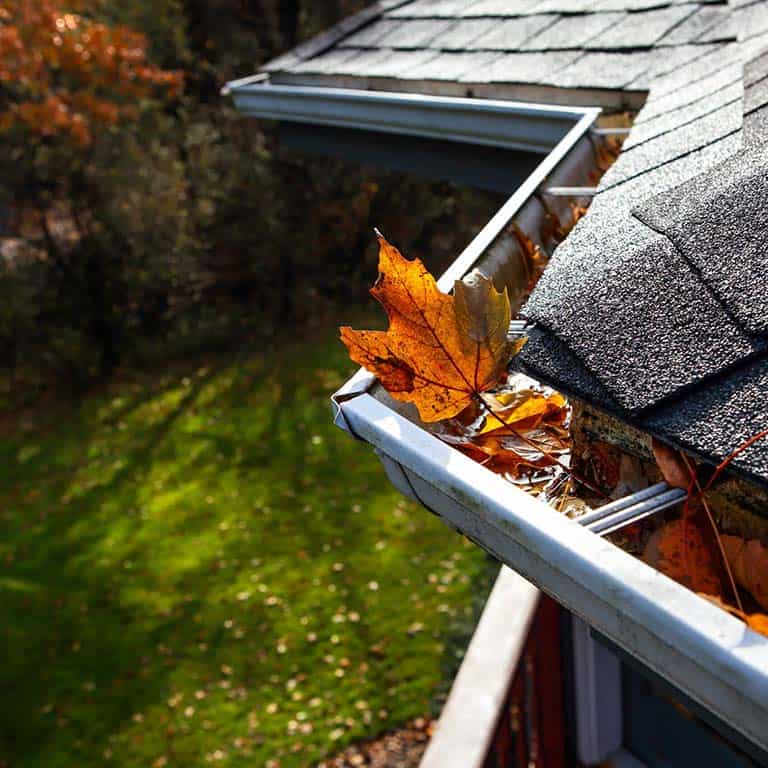No one wants to clean the gutters but doing so is a critical step in maintaining the way your home operates. Doing this before the winter is important since fall often creates a significant amount of debris in the gutters and downspouts. By removing that material, you are doing what you need to in order to maintain your home’s overall safety and health.
Gutter cleaning is a big process, though. You want to be sure that you are doing it well and in a safe manner to ensure that your home benefits and you do not end up in the ER from a fall. Though messy, there are a few ways to minimize any negative outcomes from your gutters. Here’s what you need to know.

Why Gutters are Important for the Health of Your Roof and Home
Why do gutters really matter anyway? This is definitely one of the messiest jobs that you may have to tackle. Why should you put time into doing this?
Rain gutters work to carry rain and melting snow and ice away from the home. They capture this water as it is coming off the roof and then move it away from the home. There are a few reasons why you may need to do this. First, it helps to keep water from heading to the foundation of your home and eroding away at the soil there, exposing the foundation and creating a higher risk of leaks.
In addition to this, gutters also help to prevent mold and mildew from growing around your home. That helps to protect the foundation – and really the structural integrity – of your home.
There is no doubt that you may not like the thought of cleaning gutters, but it is critical to ensure that your home isn’t at risk for damage.
Why You Can’t Leave Debris in Gutters Over Winter
Imagine the fall leaves tumble into the gutters. Over time, the wind and weather conditions, including rain, push those leaves deep into the gutters. Twigs and other materials fill up that area as well. The result is that water cannot flow into the gutters. Instead, it comes out and over the top. That material remains though.
Over the winter, it wedges deeper into the gutters. It gets into the downspout. This is wet material that may even have some makings of a nest from local critters. That wedges into the gutters and downspouts making it nearly impossible for anything to get through.
The material can harden and freeze into a large ice ball. This can create damage to the gutters themselves as it expands and contracts. At the same time, all of that wet material if creating a much higher risk for mold and mildew development. Within just a short amount of time, you have a very bad level of debris present. It smells bad, causes damage to the roofing material it comes into contact with, and even has caused the gutters to start falling off the home due to the weight.
There’s no reason to leave this material in the gutters, especially if you want to be sure that your gutters are kept in their best condition for the long term.

Tools to Help with the Job
Now that you know how important it is to keep gutters clean, your next step is to get the work done. There are a lot of materials and tools you can use to help you. The only thing you need beyond a ladder and gloves, though, is a garbage bag.
If you are not willing or able to clean out the gutters like this, and most people may not want to do that, you can purchase and use a variety of gutter cleaning tools. Some options may include:
- Telescopic hose wands: These are perfect for people who do not want to climb on a ladder but also have the time and patience to clean their gutters consistently to help remove the risk of blockage. They work by attaching to your garden hose, allowing you to simply flush out anything in the gutters themselves.
- Telescoping claws: These also work to help you avoid getting on a ladder. There is a telescoping tool that reaches into the gutters and helps to loosen material and scoop up leaves and debris in them. This is not always as easy to do as it sounds, but it can be a good option for those who do not want to do a lot of climbing.
- Scoops: There are some companies that make gutter cleaning scoops. These scoops allow you to just dig into the gutters and pull out the material as if you were shoveling it out. This method works well if you do not mind being on a ladder.
- Pressure washer attachments: Another option for cleaning gutters is to purchase an attachment that connects to your pressure washer. It allows for the nozzle to go directly into the gutters to remove debris, dirt, leaves, and anything else that builds up in them. This option is a good one if you have a pressure washer (that’s not too strong).
- Vacuum attachments: Another option is to use a vacuum attachment. These can be available for both a wet or dry shop vac. They will vacuum up the material in the gutter. You’ll need to purchase a kit that works for the vacuum system that you have.
Choose the method that works best for your situation and goals. Remember that gutter cleaning tools like these are not necessary unless you have very backed up gutters that require a significant amount of cleaning.
Gutter Cleaning Prep
The next step in the process is to prepare. You will need a ladder in most cases. You also will need gloves that can handle the wet and sloppy material. Choose those that are longer and come up your arms enough. You also may benefit from goggles, especially if you plan to clean from a ladder. This, along with a drop cloth and a few garbage bags, is all you really need to gather.
Plan to clean the gutters on a dry day (and be sure the ground itself is dry). You also do not want to clean them when it is windy outside, as that can create additional risks when you are on a ladder.
Take some time to walk around your home. Look at where all of the locations of the gutter are. Do a visual inspection. If you see any holes, rusted areas, or areas where the gutters are no longer attached to the house, you may need some bolts to help you to put them back on (or you may need to buy new sections to install).
Ladder Safety is Important
Whenever possible, do not use a ladder to get on top of your roof. Have a professional do the work. In situations where you need to do so, it is critical that you take every step possible to keep yourself safe.
Choosing the right ladder for the job is the first step in this process. A fiberglass ladder is a good idea if you are doing any type of electrical work or you will be near power lines. Aluminum ladders are a good option because they are lightweight, and it is easier to move them, but don’t use this option if there is any risk that you could be near electrical lines at all.
Consider these tips for using a ladder in a safe manner:
- Be sure to place the ladder on level ground. There should be no debris under the ladder.
- Keep the ladder at a 75 degree angle, or go with the one foot away for every four feet of ladder height you need.
- Always ensure there are three points of contact, meaning two feet and one hand, or two hands and one foot when climbing.
- Don’t extend outward beyond your arm’s natural reach. Instead, move the ladder.
- Don’t use a ladder when conditions are wet or otherwise dangerous.
Cleaning Process
Once you get onto the ladder and you are resting your body against it, you can begin to reach into the ladder to pull all of the material out. As you do this, drop the material on the drop cloth you’ve placed near the ladder to catch the material. Once you pull everything out, you should then perform a visual inspection.
Is the gutter slope still good? This is the angle that encourages the water to flow to the desired downspout. You also want to be sure that water isn’t pooling in the gutter. Watch as water or material moves down the gutter, such as when using a garden hose to wash out the gutters. Is the water flowing out the downspout and away from the home? That’s what you want to see.
Move from one area of the home to the next. The goal in this process is not to have yourself bending or straining to reach the gutter from any given position. Keep doing this, moving around the home until all of the debris is removed.
It is possible for you to then run a garden hose through the area. This helps to push anything that is in the downspouts out. Use one of the tools you’ve selected, like the power washer attachment, to help you here if needed. Free flowing water is the goal.
Before you stop cleaning up, be sure to check the overall integrity of the gutter system. Consider any areas of concern in the downspouts, too. This is also a good time to look around at the roof surface to see if there are any areas of debris or material on it or any areas of concern that may need repair. That’s another task to complete before the winter months arrive!
Consider Heat Tape Installation for Ice Dam Prevention
Now that you are cleaned up, and the area is looking good, consider what could happen this winter. If you have had ice and snow block the gutters and downspouts on your home before, it may be time to think about improving the situation. One way to do this is with the investment in heat tape. This is a type of material that is placed inside the gutters. It is a type of heating device that, once you plug it in, it warms just enough to keep ice and snow melting and allows water to continue to flow away from the home. It is not difficult to install, but it does take some time.
If you have areas where ice dams have formed before, it is important to consider the value of purchasing heat tape. The process could help you to avoid damage to the gutters in the coming years while also minimizing the risk of an ice dam causing damage to your roof (or even damaging the structural integrity of your home).
Install Gutter Guards to Lessen Gutter Maintenance
Another thing to consider now is the investment in gutter guards. You know how much time and work it just took you to clean up the gutters. It was not a fun way to spend your day, in most cases. You can see the value of keeping your gutters free moving, though. Gutter guards can offer a solution.
A gutter guard is a structural piece that is placed just inside the gutters themselves or on top of them. They have small holes that allow water to enter and move down the gutters. However, there is no way for twigs and leaves to get into the gutters. This effectively eliminates the need for annual (or more frequent) gutter cleanings.
Compare a few models and styles to determine how they may work with your current guttering system. It could be an affordable purchase you make.
Taking care of your gutters is a big part of protecting your home’s value and ensuring there are fewer risks from erosion, pooling water, mold, and mildew. Though this is a complicated task, and it may not be one you enjoy, it is one of the most important maintenance tasks you have to have.





